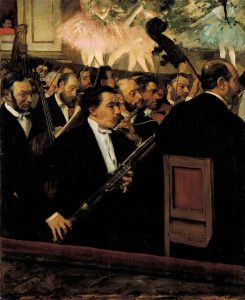Until about 1750, the orchestra did not have a defined size. During the Renaissance, instrumental formations were generally small. The pieces written during the period were often performed by different instrument ensembles, according to the occasion. This changed in the 17th century when composers began to specify desired instrumentation. At the end of the Renaissance and beginning of the Baroque, we can mention the orchestra of the opera Orfeo, by the Italian composer Claudio Monteverdi (1567-1643), which premiered in 1607, as a milestone in the history of the symphony orchestra, composed of a formation of more than 30 musicians.
The standardization of the orchestra towards its current arrangement began at the end of the Baroque period, based on string instruments – which would remain in subsequent periods -, in addition to woodwinds, such as oboes, bassoons and recorders or transverse flutes and instruments of harmonic filling, such as the harpsichord, the organ and the theorbo, according to the occasion and instrumentation. The Baroque is also the time of the emergence of concerts, whether “Concerto Solo” or “Concerto Grosso” (for a group of soloists, opposing small and large groups in the orchestra), which leads to the advancement of the technique of various instruments and stimulates the transformation in the forms of construction to allow greater possibilities. The era of instrumental virtuosity begins whose reflexes are still felt today.
In the second half of the 18th century, with the so-called “classical” composers such as Mozart, Haydn and Beethoven, the composition of the orchestra started to have the following organization: violins, violas, cellos and basses, woodwinds, harmony with instruments grouped in two and timpani. The increasing expansion of concert halls made the orchestra accompany this movement, reaching the number of 60 to 80 musicians. The great novelty of the classical period was the increasing importance of wind instruments in orchestration.
In the subsequent period, the romantic, the figure of Hector Berlioz (1803-1869) stood out. Author of the Treatise on Modern Instrumentation and Orchestration, written in 1848, which was a reference in the field for a long time, Berlioz was responsible for boosting the development of symphony orchestras by adding instruments such as the tuba, the English horn, and the bass clarinet to the harmony.

Work: L’orchestre de l’Opéra. Edgar Degas, 1868. Oil on canvas.
Collection of the Musée d’Orsay, Paris.
At the end of the 19th century, the symphonies reached their height in terms of size, with works that required more than a hundred musicians, such as Richard Wagner’s tetralogy The Ring of the Nibelung, for example.
The symphony orchestra evolved into a variable geometry orchestra from the early 20th century to the present day. One of the most significant movements of this century is, without a doubt, the development of percussion instruments that are taking an increasingly important place in music.
Sources:
Présentation générale d’un orchestre – Orchestre Symphonique de l’Aube (Aube en Champagne, França). Available at: <https://www.aube.fr/142-orchestre-symphonique-de-l-aube.htm>. Access on: Dec. 8, 2020.
ADAMI, Felipe K. Histórico do desenvolvimento orquestral. Porto Alegre. Universidade Federal do Rio Grande do Sul, 2012. Available at: <https://www.ufrgs.br/napead/projetos/orquestra-virtual/historico.php>. Access on: Dec. 8, 2020.






